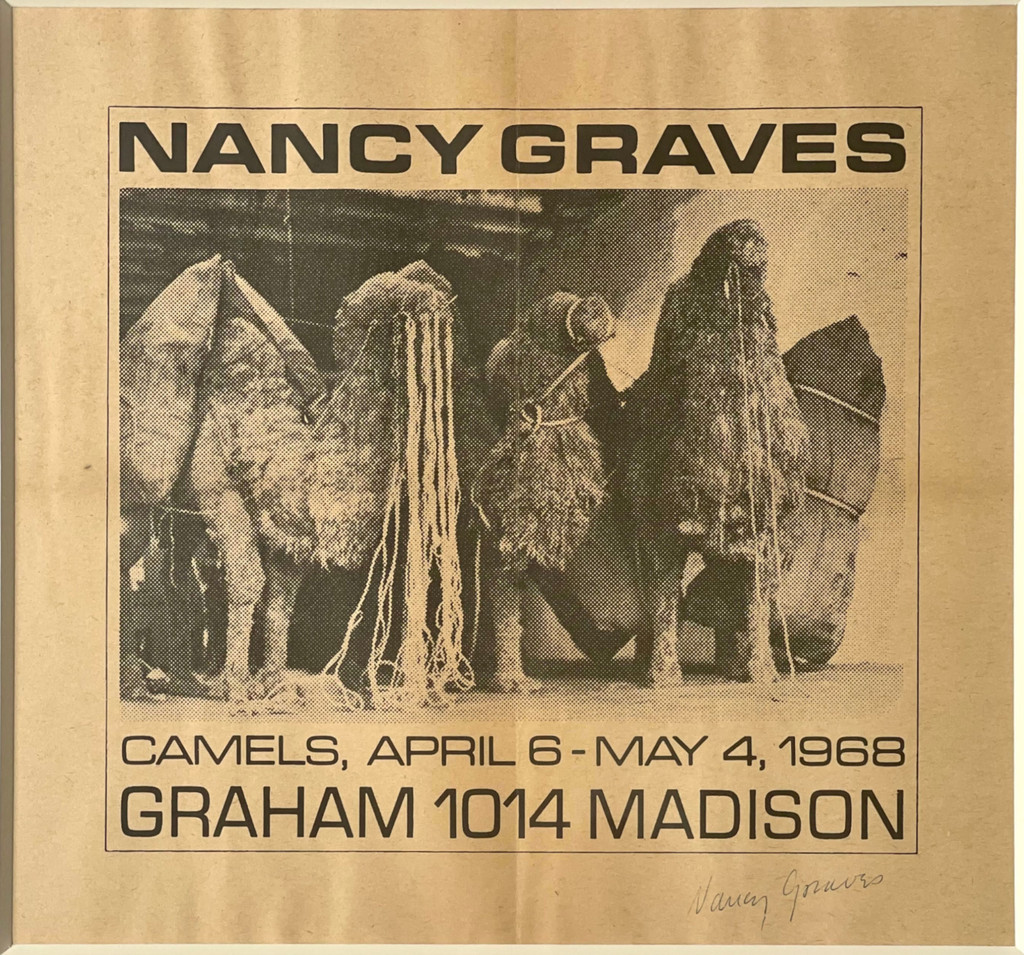
An Educated Collector is Our Best Client
In business for nearly two decades, we are a well established, popular contemporary art boutique specializing in expertly chosen, blue chip prints, multiples, uniques, books, ephemera and merchandise at different price points, with a focus on the secondary market. Please click on the "Contact Us" button at the bottom of this page for questions about any work, pricing and/or to arrange to visit our showroom/gallery - located in between Manhattan's Flatiron and Chelsea Flower Districts.
Nancy Graves, Original Graham Gallery poster (hand signed by Nancy Graves), 1968
CONTACT GALLERY FOR PRICE
Description
Nancy Graves
Original Graham Gallery poster (hand signed by Nancy Graves), 1968
Extremely rare vintage offset lithograph poster (hand signed by Nancy Graves)
hand signed by Nancy Graves in pencil on the front
Frame included
Publisher:
Graham Gallery
This late 1960s vintage Graham Gallery poster is hand signed by Nancy Graves on the front. It was published on the occasion of her "Camels" exhibition - a groundbreaking show in the artist's young life, as she died at age 54 of breast cancer. (People forget how brave she was, a sharp counterpoint to the style of the macho Minimalists of the era, like her ex husband Richard Serra.) The following year -- in 1969 - Nancy Graves became the first woman ever to have a solo show at the Whitney Museum.
We've never seen another of these prints anywhere else in the world - let alone one hand signed by Nancy Graves.
Elegantly framed in a museum quality wood frame with UV plexiglass
Measurements:
Frame:
17 x 17.5 x 1.5 inches
Work:
10 x 10.75 inches
About Nancy Graves:
Nancy Graves (1940–1995) was born in Massachusetts. Her father worked as an accountant at the local Berkshire Museum, where art was displayed with natural history. He encouraged his daughter’s early interests in art, nature and anthropology — interests which endured for the rest of her life. After graduating from Vassar College with a degree in English Literature, Graves attended Yale University, where she earned both a B.A. and an M.A. in Art, studying alongside Chuck Close, Robert Mangold and Brice Marsden.
Following Yale, she won a prestigious Fulbright Scholarship in 1964, and began studying painting in Paris — where she also married sculptor Richard Serra, whom she had met at Yale (and from whom she would divorce in 1970). Moving on to Florence soon after, she would live a somewhat nomadic life, spending time in countries that included Morocco, Kashmir, India, Egypt, Peru, Australia and Canada.
From a point of view that she described as “objective,” Graves transformed scientific sources, such as maps and diagrams, into artworks by re-producing their complex visual information in detailed paintings and drawings. Investigating the intersections between art and scientific disciplines, Graves created compelling, formally rigorous, yet ultimately expressive works of art that examine concepts of repetition, variation, verisimilitude, and the presentation and perception of visual information.
Based in SoHo, New York, Graves gained prominence in the late 1960s as a post-Minimalist artist for innovative camel, fossil, totem, and bone sculptures that were hand formed and assembled from unusual materials such as fur, burlap, canvas, plaster, latex, wax, steel, fiberglass and wood. Made in reaction to Pop and Minimalism, these works reference archaeological sites, anthropology, and natural science displays. Suspended from the ceiling or clustered directly on the floor, these early sculptures also engage with Conceptualist ideas of display. For her Whitney Museum presentation Graves exhibited three seemingly realistic sculptures of camels in an installation that evoked taxidermy specimens and questioned issues of verisimilitude in art and science, particularly in light of their hand patched and painted fur surfaces. The exhibition elicited wide spread critical responses and established her artistic significance.
After intensely engaging with sculpture in the early 1970s, Graves returned to painting. Her detailed pointillist canvasses re-produced — in paint — images culled from documentary nature photographs, NASA satellite recordings, and Lunar maps, commingling scientific exactitude with abstraction. Resuming sculpture in the late 1970s, Graves was among the first contemporary artists to experiment with bronze casting. She re-invigorated the traditional lost wax technique by assembling cast found objects into unique improbably balanced sculptures, with bright polychrome surfaces and distinctive patinas.
Throughout the 1980s Graves became widely recognized for her increasingly large and graceful open-form sculpture commissions. At the same time, she also expanded her drawing, painting, and printmaking practice and made large gestural watercolors. Then, in the late 1980s she created wall-mounted works that combined her explorations of sculpture, painting, form and color. In these large-scale pieces, she mounted high relief polychrome sculptural elements to the surfaces and edges of painted shaped canvases so that patterned shadows were cast onto the paintings and surrounding wall.
By the 1990s Graves was casting in glass, resin, paper, aluminum, and bronze, combining these varied materials and colors into daring sculptures with moving parts. As she proceeded in all the media she mastered, Graves increasingly re interpreted and transmuted forms sourced from her own earlier artwork — rather than from outside research — creating elaborate compositions that form a layered a-temporal archaeology of her own visual production.
Nancy Graves’ pioneering art anticipated ideas being explored by artists today such as data mining, multi disciplinarity, technology, and research-based art. Her work addresses philosophical, perceptual, aesthetic and technological issues that are especially relevant to making art in the digital age.
Courtesy of the Nancy Graves Foundation
















